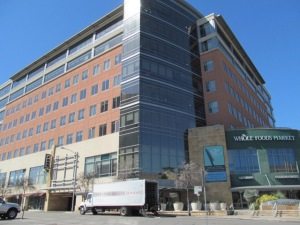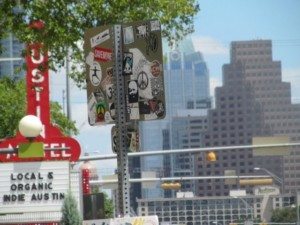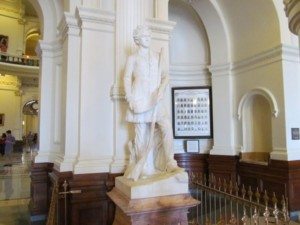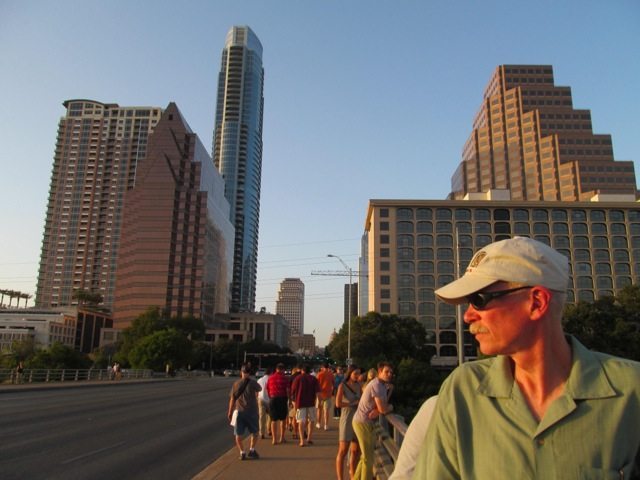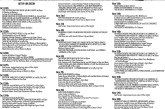With the new Whole Foods Market (WFM) being built, it seems like a good time to compare Knoxville and Austin, and to consider their relationship, if there is one, because (WFM) is the paradigm of Austin’s progression from the end of the ’70’s to the present. I’ve been pondering how Austin became what it is, and hoping Knoxville won’t follow the same path.
Whole Foods began in Austin in 1978 in an old house, and it wasn’t called WFM. It was called SaferWay. Get it? Safeway was the corporate monster of groceries, so John Mackey (WFM’s founder and CEO) and his girlfriend, residents of a vegetarian co-op and silly hippies that they were, decided they could beat Safeway at the grocery game by going organic…before most people knew what that meant. At the time, you could count the organic markets in the United States on one hand. Ergo, SaferWay.
In their 2nd year, with $5,000 profit in their pocket, they merged with another hippie food store, Clarksville Natural Grocery, and changed the name to Whole Foods Market. They rented a larger site at 10th Street and Lamar Blvd., the launching pad for what would soon become the biggest organic grocery business on the planet.
When I moved to Austin in 1985, WFM had four stores. It was still such a closely held operation at that time that John Mackey himself hired me when I applied for a job. In my year of working organically, I washed thousands of heads of lettuce, culled through tons of potatoes, and re-set displays countless times alongside my fellow “team members” and soon-to-be luminaries of the Austin music scene, musicians and singers in bands named The Wild Seeds, The Coffee Sargents, Glass Eye, Poi Dog Pondering, The Reivers, and True Believers.
In 1992, WFM went public with a stock offering that made instant millionaires of many employees who had been buying shares at 25 cents a piece with each paycheck for more than a year. And that IPO fueled acquisitions made WFM the most formidable player in the industry. Wellspring, Bread & Circus, Mrs. Gooch’s, Fresh Fields, Food for Thought, Fresh & Wild, Wild Oats, and a long list of other competitors were soon swallowed Whole.
Today, with a market capitalization of $14 billion, annual sales of $12 billion, 80,000 employees and 400 stores in the US and UK, WFM is the most Austin-tatious corporation I know…and one of the best examples you can find of what’s right about Texas.
WFM now has a sparkling world headquarters complex in Austin at the impossibly congested corner of 5th and Lamar. The flagship store is now one of the most unpleasant destinations in Austin. What used to be so wonderfully simple, is now irascibly complex.
It’s like that with everything in Austin.
Ironically, the only thing truly cool about WFM these days is the CEO’s take on ObamaCare and government in general. John Mackey’s brilliant book, Conscious Capitalism, is a must read for anyone who takes business seriously.
So what does WFM arrival mean for Knoxville? Two things. First, you’ll be able to buy produce you’ve never heard of before. Second, it ups the ante by several orders of magnitude in the hipster style wars currently being played out at Tomato Head, Three Rivers, Earth Fare,
Gourmet’s Market, and Trader Joe’s. You’uns ain’t seen nothin’ yet.
Austin and Knoxville are so similar in basic structure, they’re like first cousins. Both cities are built along beautiful rivers, in geographically pivotal spots. Both have very convenient airports, and arterial interstates barreling through their hearts. Both have great universities driving industrial innovation and football legends. Both have a laid-back joie de vive that sets them apart from, say, Memphis and Dallas. And both aspire to a totally unique greatness which may or may not be attainable.
Knoxville doesn’t boast. It enjoys being called scruffy nearly as much as it enjoys being scruffy. Austin, on the other hand, calls itself the “live music capital of the world”, and it thinks it’s the smartest, hippest, best looking city on Earth.
Of course, it’s none of those things, but its peeps do a pretty good job of fooling themselves into thinking they are the smartest, hippest, and best looking. They also started the “Keep Austin Weird” campaign, now echoed in Portland and other pretentious cities, a campaign perfectly skewered by those “Keep Knoxville Scruffy” bumper stickers.
There was a time when nobody in Austin gave a crap about smart, hip, or good looking. Or weird. That was the decade of the Armadillo, when Austin might actually have been the live music capital of the world. There had never been a music venue like the Armadillo. (Check out the archives at threadgill’s.com) And there will never be another, but in its wake, a very interesting string of Austin venues has perpetuated the idea of Austin’s musical uniqueness.
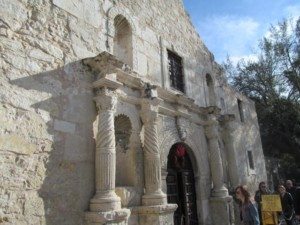 My personal favorite was Liberty Lunch, a semi-roofed enclosure which was started 40 years ago and ran until 1999. I saw the Mighty Diamonds, Flaming Lips, Joe Ely, Burning Spear, The Butthole Surfers, The Meters, Timbuk 3, Brave Combo, Nirvana, Living Color, Fishbone, Sunny Adé, Townes Van Zandt, Bjork, The Bobs, and Dolly Parton there. Now dang it, if that doesn’t strike you as eclectic, you’re just ignorant.
My personal favorite was Liberty Lunch, a semi-roofed enclosure which was started 40 years ago and ran until 1999. I saw the Mighty Diamonds, Flaming Lips, Joe Ely, Burning Spear, The Butthole Surfers, The Meters, Timbuk 3, Brave Combo, Nirvana, Living Color, Fishbone, Sunny Adé, Townes Van Zandt, Bjork, The Bobs, and Dolly Parton there. Now dang it, if that doesn’t strike you as eclectic, you’re just ignorant.
A city’s culture is about where its people go to see and be seen, and how they behave when they get there. It has been Austin’s good fortune that a lot of people over the years have risked everything they have to present great musicians in interesting venues for an audience that’s like none other in the world.
Even grocery stores are music venues in Austin. As WFM became bigger and better in the 1990’s, other local grocery stores took up the challenge of higher and hipper customer expectations. The HEB chain (that’s more appealing than its formal name, the Howard Edward Butt Grocery Company) developed a direct challenge to WFM called Central Market, which featured not only wildly expanded offerings in every department but also a cooking school, a restaurant, outdoor dining and free live music by the best musicians in the Austin scene. You can make a living in Austin as a musician playing grocery stores. That’s a fact.
The danger is in going overboard. Take SXSW. When South-by-Southwest started in 1987, it was a mildly interesting annoyance to most people who made a living in Austin as a musician, waitress or bartender at the time. Intended as a regional music festival, it instantly morphed into a beast that, with each passing year, has become unbearably hip and a make-or-break career necessity for any band on Earth with the slightest aspiration of success.
When I came home to East Tennessee a year ago, I realized Knoxville is in exactly the same position as Austin was 30 years ago, right after the publication of John Naisbett’s prophetic “Megatrends: 10 New Directions Transforming Our Lives.”
Austin took Naisbett’s formula seriously, combining the nascent trends toward a tech-friendly, global, decentralized, network-structured, Southwest-facing information society with the city’s youthful creative class and an abundance of venture capital. The result is now the fastest growing city in America …the only American city, according to Forbes Magazine, which will be mentioned a generation hence in the same breath as Shanghai, Mumbai, and Dubai as a global hub.
Well, hub’s come and go. Just ask Boston, which still considers itself The Hub of the Universe, a name it adopted back in its heyday as a whaling center. The hole in Naisbett’s predictions is that the information society with its silly social media doesn’t make anything but devices with which to view itself. The world still needs places that actually make things, full of people who know how to get dirty and make things, people who use tools and ingenuity and intuition to make things. Would Knoxville be any cooler if Twitter had been introduced at the Big Ears Festival instead of SXSW?
Texans like to say that “too much is never enough.” Sometimes, too much is way too much. Besides, everybody knows the live music capital of the world is a little place in Tennessee called Bonnaroo.
John Job is a writer from Oak Ridge.




